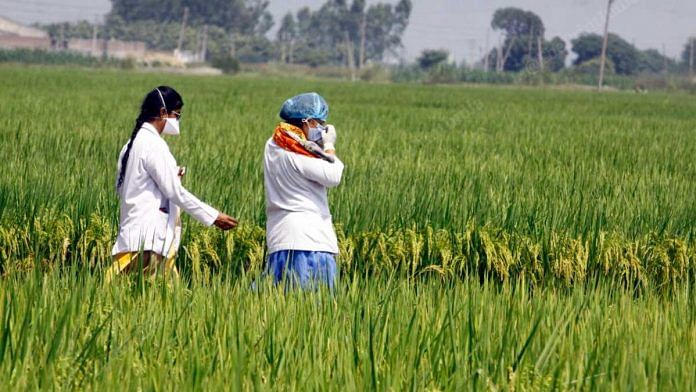Chandigarh: Punjab, which has consistently recorded India’s highest Covid fatality rate, has some good news to cheer about. Noting a remarkable turnaround, the state saw its average daily infections sharply drop to a little around 670 in October from over 2,000 in September.
Over 60,000 new Covid-19 cases were recorded in Punjab in September, but as of 30 October, the tally is just 19,752 cases.
Experts attribute the drastic shift to the global epidemiological trend of coronavirus infections starting to dip after peaking.
“We are keeping our fingers crossed. The falling numbers in Punjab are relieving. Wherever the infections have been very high the virus has shown a downward trend after peaking,” said Dr Rajesh Bhaskar, state nodal in-charge, Covid-19 management.
Punjab has so far recorded 1.33 lakh positive cases, of which 4,101 are active. Its overall positivity rate is reasonably satisfactory at 5.2 per cent, but the case fatality rate is a high 3.1 per cent.
Also read: How Kerala and Punjab became ‘worst performing states’ in their handling of Covid
Scary September
The positivity rate in September averaged around 8 per cent, close to the danger 10 per cent mark. Between 7 and 21 September, the state saw an average of 2,430 cases daily. It recorded a spike on 18 September, clocking 2,817 positive cases in a single day. In the period between 15 and 21 September, the positivity rate shot up to 9.38 per cent.
However, since 22 September, the state has seen a general downward trend that continued since. In the past one week, between 22 October and 28 October, the state saw an average 456 cases daily, bringing the positivity rate down to a low 2.16 per cent.
Testing drops, but fatality rate climbs
What makes the falling numbers even more encouraging is the fact that testing numbers have more or less remained the same over the past two months.
In September, an average of 26,000 tests were being carried out daily, marginally dipping to 24,888 in October.
This decline, government officials say, is due to a decrease in the number of positive cases.
“Since the number of positive patients has gone down, the number of tests of contacts has also gone down,” said Amit Kumar, a senior IAS officer who heads the state’s Covid-19 control room.
While around 60,000 cases were being reported from the tests, September saw 1,961 deaths of the total 4,187 reported so far. This meant 65 people were dying from the infection daily. By October, only 25 deaths were occurring on a daily average, amounting to 756 deaths as of 30 October.
Nevertheless, Punjab’s case fatality rate (CFR) has been consistently high compared to the rest of India.
The week-wise trend in October shows there’s in fact been a rise in the CFR. In the first week, the CFR was at 3.04, climbing to 3.08 in the second week, 3.13 in the third, and 3.14 in the fourth.
“There is a marginal increase in the CFR since the number of positive cases has decreased. The positivity rate has come down from (around) 9 to 2 per cent,” said Dr Bhaskar.
Also read: No masks or social distancing — In rural Punjab, life resumes like Covid never happened
What these facts mean for Punjab
On the face of it, Punjab appears to be witnessing a flattening of the curve. But officials are cautious to not get too relaxed about the situation.
“Punjab’s downward trend is a much needed relief and gives a breather to everyone who has been working day and night for the past 6-7 months to contain the epidemic. Although, the entire world is struggling to predict what happens next, (and) like everyone else, we too are fearing a second wave,” said Dr Bhaskar.
“The early trends of a second wave in some European countries is showing that while the number of cases is very large, the number of deaths is comparatively much lower. So in a second wave, the fatalities would be low but the number of people requiring hospitalisation would be much more. That would stretch our resources to the maximum and we need to be prepared for that,” he added.
Dr Pankaj Arora, an ENT specialist in the private sector, said it was too early to say Covid-19 was on the downslide. “The number of cases has decreased substantially in the past few weeks, but we are now witnessing a slight resurgence already. This could be due to the festive season or people being careless, thinking Covid has been contained,” he said.
“Like many European nations and now even the USA, there is already a second wave of infections coming in. (While) There has been a decrease in Covid infections, precautions need to continue. The vaccine is still at least six months away, if not more,” added Dr Subhash Verma, director, internal medicine and haematology, Fortis Hospital, Mohali.
Also read: Over 660 deaths, 4.1% fatality rate — why Ludhiana has Punjab’s worst Covid numbers



